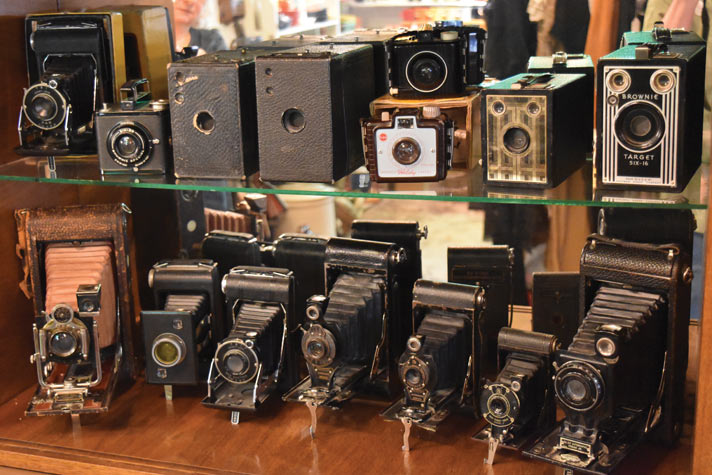Speaking of Antiquing – October 2018
Preserving an image that the eye sees is indeed a miracle of modern times. How fantastic would it be to have an actual snapshot image of the babe in the manger, or the building of the pyramids?
Fill in the blanks. Thousands of years of human history are left to the imagination. While the camera-obscura light box helped hundreds of painters and architects in creating their masterpieces by transmitting reverse imagery that was traced, it wasn’t until the late 18th century, that son of the Wedgwood pottery fame, Thomas Wedgwood, discovered that by exposing silver nitrate to the sun, he could make simple prints of an image. That discovery led to the camera.
In 1829, partners and innovators Nicephore Niepce and Louis Daguerre, figured out how to use specific chemicals to create a chemical bath for prints. Daguerre researched until he perfected what we know as the Daguerreotype print, made on silver.
Our own local history is preserved by pioneer Peter Britt, who came on foot to this valley pulling a cart with photographic equipment in 1852. He had studied Daguerreotype, and tintype photography under J. H. Fitzgibbon, in Illinois. He made a good living photographing our gold rush era, and surrounding area including his most famous photograph, Crater Lake.
Camera evolution is interesting to study. From very large wooden boxes that required head and shoulders draped in dark cloth that one person could hardly handle to hand-held, pocket sized units—all in less than half a century.
Eventually, photography became more commonplace in our culture, owing largely to George Eastman. In 1888 he registered the trademark name Kodak. His first camera was of the fixed-focus type, taking round pictures, and held film enough for 100 exposures. In the early 1890’s the folding Kodak cameras were introduced with bellows which allowed for greater compactness.
Eastman purchased the patent of S.W. Turner’s Bull Eye Camera in 1895, reconfigured the technology to create the Kodak Pocket Camera, which used his invention of film. It sold for $5 and slipped easily into one’s pocket. By 1900, Kodak introduced the most successful box camera of all time, the Brownie.
While Eastman’s competitors focused on the camera, he focused on both the camera and film. He produced most of the film for any size camera.
The 20th and 21st centuries have seen a huge leap in photographic innovations. The 35mm film to digital photography, which eventually wiped out Eastman Kodak as a company.
Camera collectors search out many styles and types, including the early bellows-type cameras, as they could still work and are fun to display. The camera field is vast for collectors, and at Pickety Place we have had a large variety of cameras pass through the shop. They don’t last long, and they are interesting as well as cultural works of art in some cases.
Pop in soon and see what remains of this interesting collection of Kodak cameras in fine condition.

 Margaret Barns is co-owner of Pickety Place Antiques & Collectibles located at 130 N. 4th Street in Jacksonville. LIKE them on
Margaret Barns is co-owner of Pickety Place Antiques & Collectibles located at 130 N. 4th Street in Jacksonville. LIKE them on